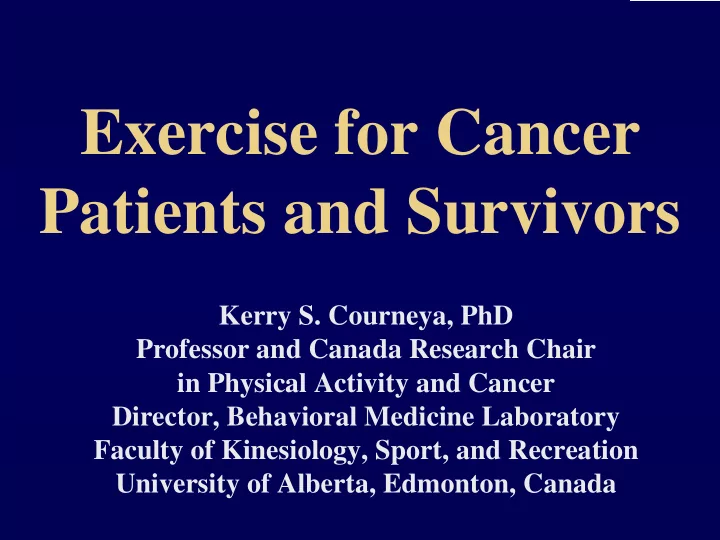

Exercise for Cancer Patients and Survivors Kerry S. Courneya, PhD Professor and Canada Research Chair in Physical Activity and Cancer Director, Behavioral Medicine Laboratory Faculty of Kinesiology, Sport, and Recreation University of Alberta, Edmonton, Canada
Canadian Cancer Statistics >200,000 Canadians diagnosed each year. lifetime probability of getting cancer almost 50%. >80,000 deaths from cancer (25% of all deaths). 5 year relative survival rate about 60% . over 1.7 million cancer survivors in Canada!
Cancer Survivorship Issues treatments are complex, difficult, prolonged. surgery, chemotherapy, radiation therapy, hormone therapy, immunotherapy. acute effects include nausea and vomiting, diarrhea, fatigue, neuropathy, pain, menopausal symptoms, insomnia, depression. chronic/late effects include cancer recurrence, second cancers, heart problems, osteoporosis.
Exercise Oncology Questions is it safe/feasible to exercise during cancer treatment? will exercise interfere with treatment or response? can exercise help manage treatment side effects? can exercise improve recovery after cancer and lower the risk of cancer recurrence? what is the optimal exercise program for benefit? are there any exercise programs for cancer patients?
Exercise Oncology Reviews >1,000 EX intervention studies in cancer patients. dozens of systematic reviews in past 20 years. early reviews on “exercise oncology”. targeted reviews have focused on specific: cancers (e.g., breast, prostate, hematologic, lung, CRC) phases (pre-treatment, treatment, survivorship, palliative) outcomes (e.g., fatigue, depression, QoL, sleep, survival) exercise interventions (e.g., aerobic, resistance, combined) combinations (breast on Tx, prostate on ADT)
Supervised Trial of Aerobic versus Resistance Training (START) RCT examining AET versus RET versus UC in 242 BC patients on chemotherapy. multicenter trial: Edmonton, Ottawa, and Vancouver. (Courneya et al. JCO 2007;25:4396-4404)
Chemotherapy Received (RDI) 95 P=.033 90 Relative Dose Intensity P=.266 85 80 75 UC RET AET (Courneya et al. JCO 2007;25:4396-4404)
Disease-Free Survival 8-year DFS was 82.7% for EX vs. 75.6% for UC (Courneya et al. MSSE 2014;46:1744-51)
Healthy Exercise for Lymphoma Patients (HELP) Trial RCT comparing AET to UC in 122 lymphoma patients on chemotherapy (n=54) or off Tx (n=68). 12 weeks supervised exercise training. primary endpoint was QoL. secondary endpoints were treatment outcomes. (Courneya et al. J Clin Onc 2009;27:4605-12)
Effects of Exercise on Chemotherapy Completion Rate 110 P=.45 P=.20 UC AET 100 % Completion Rate 90 80 70 60 50 % of minimum % of maximum (Courneya et al. J Clin Onc 2009;27:4605-12)
Effects of Exercise on Treatment Response 60 13/28 UC AET 50 P=.24 % With Response 40 8/26 30 20 10 0 Stable Partial Complete (Courneya et al. J Clin Onc 2009;27:4605-12)
Effects of Exercise on Treatment Response 90 UC AET 80 70 10/18 P=.020 60 % With Response 50 40 30 3/17 20 10 0 Partial Complete (Morielli et al., unpublished)
Summary of Evidence EX is safe/feasible during cancer treatment and does not interfere with treatments or worsen symptoms. EX maintains/improves health-related fitness even during difficult cancer treatments. EX prevents/manages some side effects during treatment (especially for symptomatic patients). EX during treatment may improve treatment completion, response, and long term cancer outcomes.
Don’t Take Cancer Lying Down!
Exercise Recommendations 150 minutes/week of moderate intensity aerobic EX. 75 minutes/week of vigorous intensity aerobic EX. 2-3 days/week of strength exercises of major muscle groups using 8-12 repetitions and 1-2 sets. add “activity supplements” throughout the day. older adults may add balance exercises.
General Exercise Principles avoid inactivity; sedentary behavior may be bad. some exercise is better than none. more exercise is better (dose-response). start easy/progress slowly (exercise to tolerance). exercise must be individualized based on patient function, side effects, goals, and preferences.
(Cormie et al. Med J Aus 2018;1-4)
How Do We Move Exercise Oncology Research into Cancer Care?
Two Models of Exercise Promotion CLINICAL MODEL: (on treatment/late stage) higher risk:benefit ratio. medical consultation often needed. personalized exercise prescription needed. supervised exercise recommended focus on cancer-specific outcomes. PUBLIC HEALTH MODEL: (off treatment/cured) lower risk:benefit ratio. home-based exercise feasible/distance-based support. general exercise recommendations more appropriate. focus on disease prevention and health promotion.
( https://www.albertacancerexercise.com/ )
Cancer-specific Motives/Benefits prepare for treatments (“prehabilitation”). complete treatments. respond to treatments. manage treatment side effects. recover after treatments. reduce risk of recurrence/death from cancer.
Cancer-specific Social Influencers oncologists (medical, radiation, surgical). oncology care providers (nurse, phyiso/nut., psych.). cancer treatment centers. cancer societies/support groups (CCS, ACS). other cancer survivors.
Cancer-specific Barriers/Constraints side effects/toxicities from treatment (fatigue, nausea, diarrhea, neuropathy, pain, hand-foot syndrome, urinary incontinence, skin problems, dyspnea, mouth problems, anxiety, depression). medical appointments, work-related issues. access to programs/qualified personnel.
Safety (risks) of EX in Cancer Patients
Who is Likely to Benefit from a Cancer-Specific EX Intervention? newly diagnosed cancer patients starting treatments. patients receiving or recovering from treatments. cancer patients with poor or modest prognosis. patients with advanced or metastatic cancer. EXCEPTION: long term survivors of early stage cancers with good prognosis and few morbidities.
EX Intervention Recommendations in Cancer Survivors incorporate cancer-specific benefits where supported by the evidence, invoke cancer-specific social influencers important to the individual, address cancer-specific barriers and precautions, all of which may vary by cancer type, disease stage, treatments received, and cancer trajectory.
Summary and Conclusions cancer is a compelling disease for most people. most cancer patients want cancer-specific EX information, not general health information. cancer affects all aspects of EX behavior change interventions including motives, barriers, social influences, and delivery (who, what, when, where).
Acknowledgements Many colleagues, students, staff and study participants have contributed to this research. K.S. Courneya is supported by the Canada Research Chairs Program, a CIHR Foundation Grant, and Apple Fitness.
Recommend
More recommend